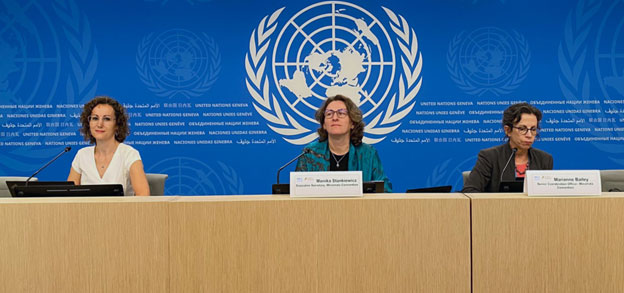Seize Opportunity to End Last Major Mercury Device

WASHINGTON DC, Oct 13 (IPS) - As the Minamata Convention on Mercury’s fifth Conference of the Parties (COP5) approaches, momentum builds to adopt the Africa Region’s proposed amendment to phase out dental amalgam – a cavity filling material that is approximately 50% mercury.
The fifth meeting of the Conference of the Parties to the Minamata Convention on Mercury (COP-5) will take place from Monday, 30 October to Friday, 3 November 2023 at the International Conference Centre (CICG) in Geneva, Switzerland. More than eight hundred participants – including Parties’ representatives, non-parties governments, intergovernmental organizations, UN bodies and NGOs – are already confirmed to attend the meeting, according to UNEP.
Specifically, the Africa Region has filed a proposal to amend the Minamata Convention to add a 2030 phase-out date for amalgam, bringing it in line with many other mercury products. The proposal also adds common-sense measures to facilitate this phase-out, including (1) submitting to the Secretariat a national plan for phasing out the use of dental amalgam and (2) excluding the use of dental amalgam in government insurance policies and programs.
This amendment is already getting support from governments around the world. On 9 October the World Alliance for Mercury-Free Dentistry hosted a webinar on phasing out amalgam, featuring distinguished speakers ranging from the Honorable MP Nilto Tatto of Brazil to the Honorable Minister Roger Baro of Burkina Faso, from Dr. Luu Hoang Ngoc of Vietnam, the longest-serving Minamata delegate in Asia, to Joshua Sam of SPREP, architect of the Mercury-Free Pacific campaign—as well as dentists from three continents.
The momentum to end use of this primitive pollutant from the colonial era is substantial; more than 40 nations have enacted amalgam bans or partial bans:
- Ending amalgam use in children, pregnant women, and breastfeeding women (e.g., the European Union, Vietnam)
- Setting a phase-out date for all amalgam use (e.g., Tanzania, Italy)
- Banning amalgam use by law (e.g., Philippines, Moldova, Mongolia, Bolivia, New Caledonia)
- Ending amalgam use by shareholder consensus (e.g., St. Kitts & Nevis, Zambia)
- Ending amalgam imports (e.g., Cuba, Colombia)
- Ending amalgam use in public programs (e.g., Indonesia, Poland)
- Ending amalgam use in armed forces (e.g., India, Bangladesh)
These countries are working to end amalgam because they understand the many benefits of moving away from mercury products like amalgam – and toward a mercury-free world.
First, moving away from amalgam protects the environment from amalgam’s mercury. Between 226 and 322 tonnes of dental mercury is used around the world annually. Dental mercury enters the environment via many unsound pathways, polluting air via cremation, dental clinic emissions, and sludge incineration; water via dental clinic releases and human waste; and soil via landfills, burials, and fertilizer.
Studies show that after environmental costs are factored in amalgam is more expensive than mercury-free fillings, but these mercury-free alternatives eliminate the high environmental costs of amalgam.
Second, moving away from amalgam reduces human exposure to mercury. Dental amalgam releases mercury throughout its lifecycle. Higher levels of exposure to mercury (for both patients and dental workers) are associated with placement and removal of dental amalgams.
Once implanted in teeth, dental amalgam continues to release low levels of mercury vapor, with higher amounts released during mastication, gum chewing, tooth grinding, and tooth brushing. Phasing out amalgam will eliminate this source of exposure.
Third, moving away from amalgam actually improves oral health because of the advantages of mercury-free fillings. Studies show mercury-free composite fillings can last as long as – and even longer than – amalgam.
They preserve tooth structure that must be removed to place an amalgam filling, which can increase the longevity of the tooth itself. They can even help prevent future caries.
While support for the Africa Region’s proposed amalgam phase-out amalgam has been steadily building, the amalgam industry has been pushing back. Led by the pro-mercury World Dental Federation, the industry has issued a controversial letter that seemingly promotes a two-tiered system of dentistry: toxic-free dentistry for wealthy countries and mercury-based dentistry for lower-income countries.
Such health inequity and environmental injustice is unacceptable. The world has witnessed such outrageous disparities before, such as when Western nations banned lead paint at home but sold it to Asian, African, and Latin American nations. All countries worldwide, not only wealthy ones, deserve to benefit from mercury-free dental care.
At COP4, held last year in Indonesia, the Parties to the Minamata Convention added the Children’s Amendment, which requires each Party to “…Exclude or not allow, by taking measures as appropriate, or recommend against the use of dental amalgam for the dental treatment of deciduous teeth , of patients under 15 years and of pregnant and breastfeeding women…”
Now the Parties have a great opportunity take the next logical step at COP5: phase out the 200-year mistake of mercury amalgam dental fillings. During the week of 30 October to 3 November, the world will choose whether to accept the industry’s two-tiered system of dentistry that off-loads mercury into Africa, into Asia, and into Latin America – or embrace a mercury-free future for dentistry. It’s time to make dental mercury history!
Charlie Brown is president, World Alliance for Mercury-Free Dentistry
IPS UN Bureau
Follow @IPSNewsUNBureau
Follow IPS News UN Bureau on Instagram
© Inter Press Service (2023) — All Rights Reserved. Original source: Inter Press Service
 Global Issues
Global Issues